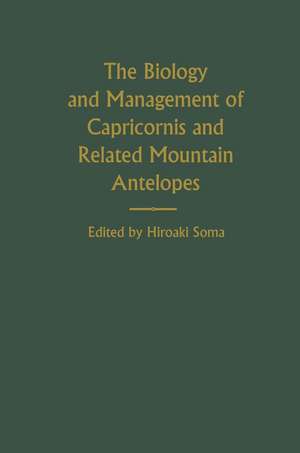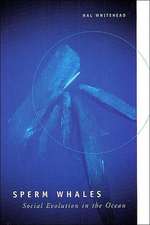The Biology and Management of Capricornis and Related Mountain Antelopes
Editat de Hiroaki Somaen Limba Engleză Paperback – 5 mai 2012
Preț: 394.29 lei
Nou
Puncte Express: 591
Preț estimativ în valută:
75.45€ • 78.33$ • 62.92£
75.45€ • 78.33$ • 62.92£
Carte tipărită la comandă
Livrare economică 22 martie-05 aprilie
Preluare comenzi: 021 569.72.76
Specificații
ISBN-13: 9789401180320
ISBN-10: 9401180326
Pagini: 404
Ilustrații: XI, 391 p. 102 illus.
Dimensiuni: 155 x 235 x 21 mm
Greutate: 0.56 kg
Ediția:Softcover reprint of the original 1st ed. 1987
Editura: SPRINGER NETHERLANDS
Colecția Springer
Locul publicării:Dordrecht, Netherlands
ISBN-10: 9401180326
Pagini: 404
Ilustrații: XI, 391 p. 102 illus.
Dimensiuni: 155 x 235 x 21 mm
Greutate: 0.56 kg
Ediția:Softcover reprint of the original 1st ed. 1987
Editura: SPRINGER NETHERLANDS
Colecția Springer
Locul publicării:Dordrecht, Netherlands
Public țintă
ResearchCuprins
One: Evolution and Breeding History of the Rupicaprini.- 1 On the evolution of the Caprinae.- 2 The saiga (Saiga tatarica) in captivity, with special reference to the Zoological Society of San Diego.- 3 Evolutionary aspects of the biology of chamois, Rupicapra spp. (Bovidae, Caprinae).- 4 Evolutionary pathways of karyotypes of the tribe Rupicaprini.- Two: Ecological Distribution and Behaviour of Capricornis.- 5 Survey of 217 Japanese serows, Capricornis crispus, bred in captivity.- 6 Distribution of Japanese serow in its southern range, Kyushu.- 7 Family break-up in Japanese serow, Capricornis crispus.- 8 Censusing Japanese serow by helicopter in deciduous mountain forests.- 9 Radio tracking of Japanese serow in Akita Prefecture, Japan.- 10 A preliminary study on the ecology of Formosan serow, Capricornis crispus swinhoei.- 11 Social behaviour of Japanese serow, Capricornis crispus crispus.- Three: Keeping and Breeding of Capricornis.- 12 Breeding of Sumatran serow at Dusit Zoo.- 13 Breeding and behaviour of Formosan serow at Taipei Zoo.- 14 Behaviour of the Japanese serow (Capricornis crispus) at the San Diego Wild Animal Park.- Four: Ecology and Breeding of the Rupicaprini.- 15 Keeping and breeding of chamois (Rupicapra rupicapra rupicapra Linné 1758) at the Alpine Zoo, Innsbruck/Tirol.- 16 Experiences of keeping and breeding saiga antelope at Tierpark, Berlin.- 17 Breeding of Mongolian gazelle at Osaka Zoo.- 18 Nemorhaedus cranbrooki Hayman.- 19 Breeding of goral, Formosan serow and chamois.- Five: Anatomy of Capricornis.- 20 Morphological characteristics of Japanese serow, with special reference to the interdigital glands.- 21 Histology and lipid analysis of the infraorbital gland of Japanese serow, and functional considerations.- 22 Brachial and lumbosacralplexuses and brains of the Japanese serow.- 23 What can serow horns tell us?.- Six: Diseases of the Rupicaprini.- 24 Clostridial infections in chamois (Rupicapra rupicapra) in captivity.- 25 Pathological studies on Japanese serow (Capricornis crispus).- 26 Serological survey for selected microbial pathogens in Japanese serow (Capricornis crispus) in Gifu Prefecture, Japan.- 27 Haematological and biochemical findings on Japanese serow.- Seven: Endocrinology and Reproduction of Capricornis.- 28 Reproduction of female Japanese serow based on the morphology of ovaries and fetuses.- 29 Seasonal changes in male reproductive functions of Japanese serow.- 30 Steroid hormone synthesis and secretion by adrenals of wild Japanese serow, Capricornis crispus.- Eight: Nutritional Status of Capricornis.- 31 The quantity of food taken by raised Japanese serow.- 32 Nutritional estimation of Japanese serow by faecal analysis.- 33 Heavy metal accumulation in wild Japanese serow.





